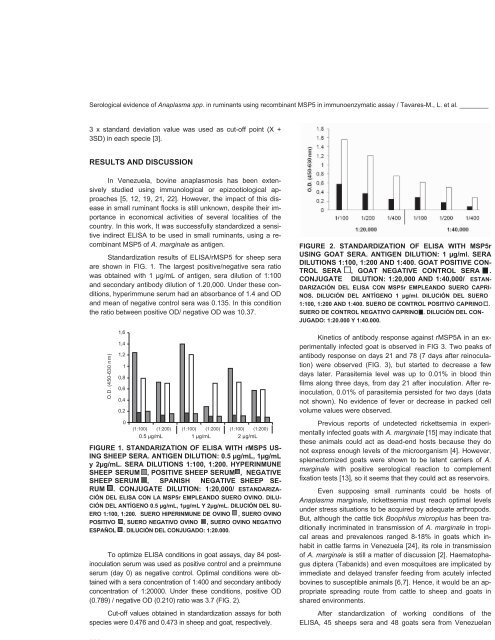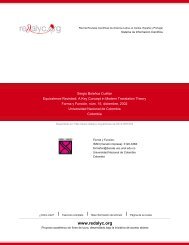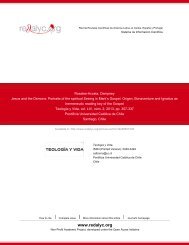Redalyc.Serological evidence of Anaplasma spp. in small ruminants ...
Redalyc.Serological evidence of Anaplasma spp. in small ruminants ...
Redalyc.Serological evidence of Anaplasma spp. in small ruminants ...
You also want an ePaper? Increase the reach of your titles
YUMPU automatically turns print PDFs into web optimized ePapers that Google loves.
<strong>Serological</strong> <strong>evidence</strong> <strong>of</strong> <strong>Anaplasma</strong> <strong>spp</strong>. <strong>in</strong> rum<strong>in</strong>ants us<strong>in</strong>g recomb<strong>in</strong>ant MSP5 <strong>in</strong> immunoenzymatic assay / Tavares-M., L. et al. ________<br />
3 x standard deviation value was used as cut-<strong>of</strong>f po<strong>in</strong>t (X +<br />
3SD) <strong>in</strong> each specie [3].<br />
RESULTS AND DISCUSSION<br />
In Venezuela, bov<strong>in</strong>e anaplasmosis has been extensively<br />
studied us<strong>in</strong>g immunological or epizootiological approaches<br />
[5, 12, 19, 21, 22]. However, the impact <strong>of</strong> this disease<br />
<strong>in</strong> <strong>small</strong> rum<strong>in</strong>ant flocks is still unknown, despite their importance<br />
<strong>in</strong> economical activities <strong>of</strong> several localities <strong>of</strong> the<br />
country. In this work, It was successfully standardized a sensitive<br />
<strong>in</strong>direct ELISA to be used <strong>in</strong> <strong>small</strong> rum<strong>in</strong>ants, us<strong>in</strong>g a recomb<strong>in</strong>ant<br />
MSP5 <strong>of</strong> A. marg<strong>in</strong>ale as antigen.<br />
Standardization results <strong>of</strong> ELISA/rMSP5 for sheep sera<br />
are shown <strong>in</strong> FIG. 1. The largest positive/negative sera ratio<br />
was obta<strong>in</strong>ed with 1 µg/mL <strong>of</strong> antigen, sera dilution <strong>of</strong> 1:100<br />
and secondary antibody dilution <strong>of</strong> 1.20,000. Under these conditions,<br />
hyperimmune serum had an absorbance <strong>of</strong> 1.4 and OD<br />
and mean <strong>of</strong> negative control sera was 0.135. In this condition<br />
the ratio between positive OD/ negative OD was 10.37.<br />
O.D. (450-630 nm)<br />
1,6<br />
1,4<br />
1,2<br />
1<br />
0,8<br />
0,6<br />
0,4<br />
0,2<br />
0<br />
(1:100) (1:200) (1:100) (1:200) (1:100) (1:200)<br />
0.5 µg/mL 1 µg/mL 2 µg/mL<br />
FIGURE 1. STANDARIZATION OF ELISA WITH rMSP5 US-<br />
ING SHEEP SERA. ANTIGEN DILUTION: 0.5 µg/mL, 1µg/mL<br />
y 2µg/mL. SERA DILUTIONS 1:100, 1:200. HYPERINMUNE<br />
SHEEP SERUM , POSITIVE SHEEP SERUM , NEGATIVE<br />
SHEEP SERUM , SPANISH NEGATIVE SHEEP SE-<br />
RUM . CONJUGATE DILUTION: 1:20,000/ ESTANDARIZA-<br />
CIÓN DEL ELISA CON LA MSP5r EMPLEANDO SUERO OVINO. DILU-<br />
CIÓN DEL ANTÍGENO 0.5 µg/mL, 1µg/mL Y 2µg/mL. DILUCIÓN DEL SU-<br />
ERO 1:100, 1:200. SUERO HIPERINMUNE DE OVINO , SUERO OVINO<br />
POSITIVO , SUERO NEGATIVO OVINO , SUERO OVINO NEGATIVO<br />
ESPAÑOL . DILUCIÓN DEL CONJUGADO: 1:20.000.<br />
To optimize ELISA conditions <strong>in</strong> goat assays, day 84 post<strong>in</strong>oculation<br />
serum was used as positive control and a preimmune<br />
serum (day 0) as negative control. Optimal conditions were obta<strong>in</strong>ed<br />
with a sera concentration <strong>of</strong> 1:400 and secondary antibody<br />
concentration <strong>of</strong> 1:20000. Under these conditions, positive OD<br />
(0.789) / negative OD (0.210) ratio was 3.7 (FIG. 2).<br />
Cut-<strong>of</strong>f values obta<strong>in</strong>ed <strong>in</strong> standardization assays for both<br />
species were 0.476 and 0.473 <strong>in</strong> sheep and goat, respectively.<br />
FIGURE 2. STANDARDIZATION OF ELISA WITH MSP5r<br />
USING GOAT SERA. ANTIGEN DILUTION: 1 µg/ml. SERA<br />
DILUTIONS 1:100, 1:200 AND 1:400. GOAT POSITIVE CON-<br />
TROL SERA , GOAT NEGATIVE CONTROL SERA .<br />
CONJUGATE DILUTION: 1:20,000 AND 1:40,000/ ESTAN-<br />
DARIZACIÓN DEL ELISA CON MSP5r EMPLEANDO SUERO CAPRI-<br />
NOS. DILUCIÓN DEL ANTÍGENO 1 µg/ml. DILUCIÓN DEL SUERO<br />
1:100, 1:200 AND 1:400. SUERO DE CONTROL POSITIVO CAPRINO .<br />
SUERO DE CONTROL NEGATIVO CAPRINO . DILUCIÓN DEL CON-<br />
JUGADO: 1:20.000 Y 1:40.000.<br />
K<strong>in</strong>etics <strong>of</strong> antibody response aga<strong>in</strong>st rMSP5A <strong>in</strong> an experimentally<br />
<strong>in</strong>fected goat is observed <strong>in</strong> FIG 3. Two peaks <strong>of</strong><br />
antibody response on days 21 and 78 (7 days after re<strong>in</strong>oculation)<br />
were observed (FIG. 3), but started to decrease a few<br />
days later. Parasitemia level was up to 0.01% <strong>in</strong> blood th<strong>in</strong><br />
films along three days, from day 21 after <strong>in</strong>oculation. After re<strong>in</strong>oculation,<br />
0.01% <strong>of</strong> parasitemia persisted for two days (data<br />
not shown). No <strong>evidence</strong> <strong>of</strong> fever or decrease <strong>in</strong> packed cell<br />
volume values were observed.<br />
Previous reports <strong>of</strong> undetected rickettsemia <strong>in</strong> experimentally<br />
<strong>in</strong>fected goats with A. marg<strong>in</strong>ale [15] may <strong>in</strong>dicate that<br />
these animals could act as dead-end hosts because they do<br />
not express enough levels <strong>of</strong> the microorganism [4]. However,<br />
splenectomized goats were shown to be latent carriers <strong>of</strong> A.<br />
marg<strong>in</strong>ale with positive serological reaction to complement<br />
fixation tests [13], so it seems that they could act as reservoirs.<br />
Even suppos<strong>in</strong>g <strong>small</strong> rum<strong>in</strong>ants could be hosts <strong>of</strong><br />
<strong>Anaplasma</strong> marg<strong>in</strong>ale, rickettsemia must reach optimal levels<br />
under stress situations to be acquired by adequate arthropods.<br />
But, although the cattle tick Boophilus microplus has been traditionally<br />
<strong>in</strong>crim<strong>in</strong>ated <strong>in</strong> transmission <strong>of</strong> A. marg<strong>in</strong>ale <strong>in</strong> tropical<br />
areas and prevalences ranged 8-18% <strong>in</strong> goats which <strong>in</strong>habit<br />
<strong>in</strong> cattle farms <strong>in</strong> Venezuela [24], its role <strong>in</strong> transmission<br />
<strong>of</strong> A. marg<strong>in</strong>ale is still a matter <strong>of</strong> discussion [2]. Haematophagus<br />
diptera (Tabanids) and even mosquitoes are implicated by<br />
immediate and delayed transfer feed<strong>in</strong>g from acutely <strong>in</strong>fected<br />
bov<strong>in</strong>es to susceptible animals [6,7]. Hence, it would be an appropriate<br />
spread<strong>in</strong>g route from cattle to sheep and goats <strong>in</strong><br />
shared environments.<br />
After standardization <strong>of</strong> work<strong>in</strong>g conditions <strong>of</strong> the<br />
ELISA, 45 sheeps sera and 48 goats sera from Venezuelan
















